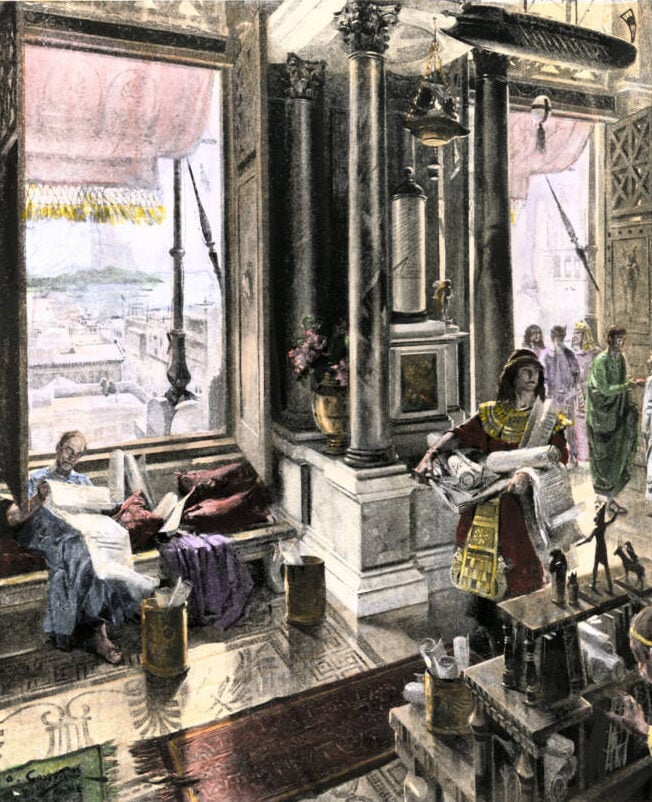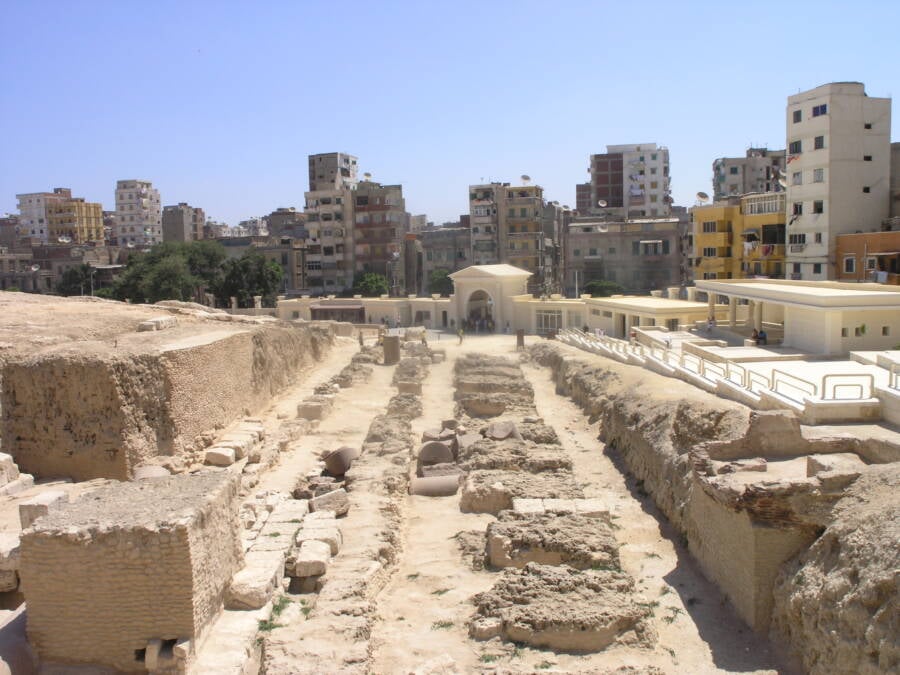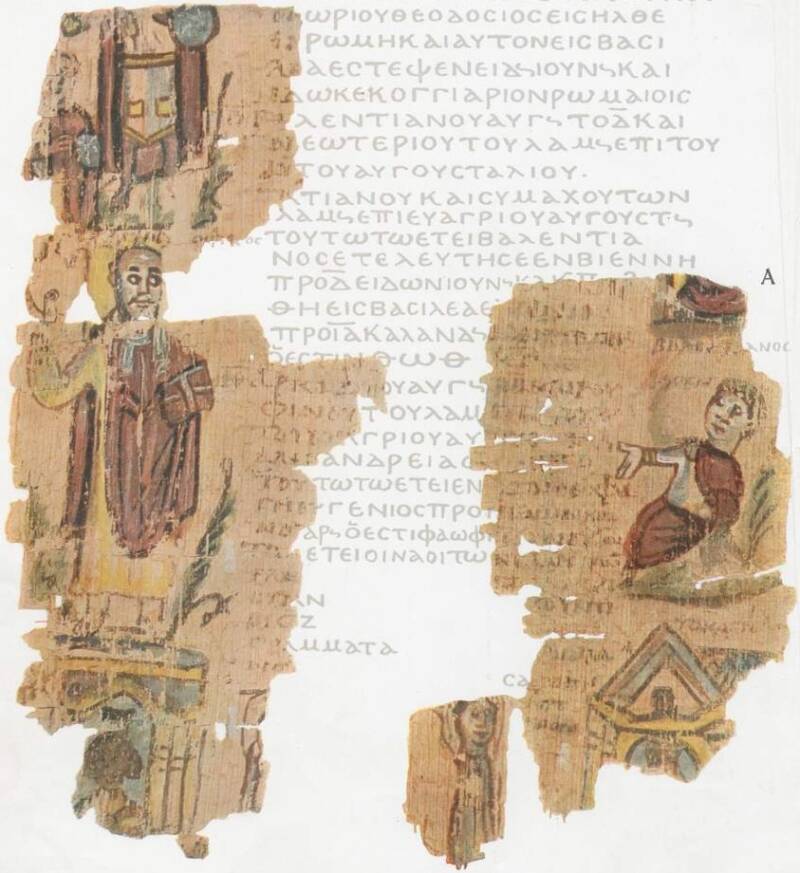Legend says that Julius Caesar accidentally burned the Library of Alexandria in 48 B.C.E., but historians think the institute slowly declined over centuries.

Public DomainAncient sources estimate that the Library of Alexandria held anywhere from 40,000 to 700,000 texts.
The Library of Alexandria was once the center of knowledge of the ancient world. Founded around the third century B.C.E., the institution was said to have housed as many as 700,000 texts at its peak.
Its vast collections included everything from the works of Greek philosophers to Babylonian manuscripts. Those in charge of obtaining new books went to extremes to ensure that they didn’t miss anything important, allegedly searching every single ship that sailed into Alexandria’s harbor for texts to add to the shelves.
However, almost as quickly as it rose, the Library of Alexandria fell. It had all but vanished from the historical record by the fourth century C.E. So, what happened to the ancient wonder?
Was Julius Caesar really responsible for the burning of the Library of Alexandria? Was it destroyed by Christian forces who wanted to erase any remnants of Paganism? Or did the library simply suffer a steady decline as other ancient cities rose to prominence?
Here’s what history says.
The Library Of Alexandria’s Enigmatic Beginnings
With no surviving archaeological ruins and varying historical accounts, it is difficult to pinpoint the exact origins of the Library of Alexandria.
The earliest known source describing the founding of the library comes from the Letter of Aristeas, which dates to the late third or early second century B.C.E. The correspondence was purportedly written by the poet Aristeas of Marmora to someone named Philocrates.
The letter reads, “Demetrius of Phalerum, as keeper of the king’s library, received large grants of public money with a view to his collecting, if possible, all the books in the world; and by purchases and transcriptions he to the best of his ability carried the king’s purpose into execution.”

Public DomainA map of ancient Alexandria. The library would have been located in the area labeled “Bruchium.”
Some scholars have suggested that this king was Ptolemy I Soter, who ruled from 305 to 282 B.C.E. However, others believe the letter is an unreliable source and instead put forth the theory that the Library of Alexandria was constructed during the reign of Ptolemy I’s successor, Ptolemy II Philadelphus, between 284 and 246 B.C.E.
Regardless of who established the library, it quickly transformed Alexandria into a hub of knowledge. It was built as part of the research institution known as the Mouseion, or the “Shrine of the Muses,” in Alexandria, Egypt.
As for its appearance, the library was an awe-inspiring spectacle. In the late first century B.C.E. or early first century C.E., the Greek historian Strabo described the institution in his Geography:
The Museum is a part of the palaces. It has a public walk and a place furnished with seats, and a large hall, in which the men of learning, who belong to the Museum, take their common meal. This community possesses also property in common; and a priest, formerly appointed by the kings, but at present by Caesar, presides over the Museum.
These “men of learning” came from around the ancient world, drawn to the Library of Alexandria because of its impressive collection of texts. Indeed, its shelves were said to hold the totality of ancient knowledge.
Inside The Collections Of The Ancient Library
According to various sources, the Library of Alexandria housed anywhere from 40,000 to 700,000 books. The Letter of Aristeas states that, when asked how many texts were in the library’s collection, Demetrius of Phalerum responded, “‘More than two hundred thousand, O king; and I will ere long make diligent search for the remainder, so that a total of half a million may be reached.'”
These books were gathered in numerous ways. Some were purchased for vast sums of money, such as the works of Aristotle, according to some sources. Others were confiscated from ships that docked in Alexandria. Library officials allegedly searched each vessel that entered the harbor, confiscated any books found on board, and took them to the institution. There, someone would decide whether to confiscate each manuscript or return it. If the text was needed for the library’s collections, scribes would quickly make a copy to return to the ship.

North Wind Picture Archives / Alamy Stock PhotoA depiction of scholars using the Library of Alexandria circa 200 B.C.E.
One legend claims that Ptolemy III was determined to obtain the original works of Aeschylus, Sophocles, and Euripides, which were kept in the state archives in Athens. As the story goes, the king offered a hefty deposit to borrow the manuscripts in order to make copies for the library. He sent the copies back to Athens instead, forfeiting his money.
The majority of the works found in the library were written in Greek, including medical texts by Hippocrates, poetry by Sappho, the writings of Plato and Aristotle, and various scientific articles. However, the shelves also held Egyptian, Babylonian, Persian, Assyrian, Indian, Hebrew, Zoroastrian, and Buddhist texts.
Callimachus of Cyrene was reportedly tasked with creating the world’s first library catalog, in which he divided every text held within the institution into 11 categories: rhetoric, law, epic, tragedy, comedy, lyric poetry, history, medicine, mathematics, natural science, and miscellaneous.

Daniel Mayer/Wikimedia CommonsThe ruins of the Serapeum, which housed a second branch of the Library of Alexandria.
Within 50 years of its creation, the Library of Alexandria’s collections had grown so large that a second branch was constructed in the Serapeum, a nearby temple to the deity Serapis.
So, how did such a vital asset to the ancient world vanish within a few centuries?
Theories About The Downfall Of The Library Of Alexandria
The most popular story of the Library of Alexandria’s demise involves none other than Julius Caesar. In 48 B.C.E., Caesar was engaged in a civil war against Pompey for control of the Roman Republic. The conflict reached the shores of Alexandria, where Caesar also became involved in a dispute between Cleopatra and her brother, Ptolemy XIII.
At one point, Caesar decided to set fire to enemy ships in the harbor of Alexandria to avoid defeat. The blaze spread through the city, purportedly destroying the great library. Or did it?

Science History Images / Alamy Stock PhotoWhile the burning of the Library of Alexandria is almost certainly a myth, it’s perhaps the best known story about the ancient institution.
Modern scholars don’t believe that the burning of the Library of Alexandria actually happened. They point to the fact that ancient writers mention visiting the institution after 48 B.C.E.
Instead, many historians theorize that the library suffered a more gradual decline.
In the second century B.C.E., Ptolemy VIII expelled many scholars from the city. They moved to places like Athens and Rhodes, transforming them into academic hubs in their own right.
As the influence of the Library of Alexandria waned, its collections were sold off bit by bit. Then, in the fourth century C.E., Christian zealots destroyed the Serapeum and the second branch of the library, and a church was later built on the site.

Public DomainA fifth-century depiction of Pope Theophilus of Alexandria standing atop the Serapeum just before he destroyed it in 391 C.E.
While the ancient library has been gone for nearly 2,000 years now, it remains an important part of classical history. The story of the burning of the Library of Alexandria, even if false, is well known to this day, and it’s sometimes even used as a metaphor for the loss of biological diversity in the modern world.
We may never know what really happened to the celebrated institution, and any full accounts of what it once held have been lost to time. However, records do tell us how the Library of Alexandria once helped the greatest minds of the time carry out their valuable scholarship.
After reading about the Library of Alexandria, dive into the story of the Lighthouse of Alexandria, one of the Seven Wonders of the Ancient World. Then, learn about the Colossus of Rhodes, the 108-foot-tall bronze statue that guarded the entrance to the ancient city of Rhodes.





